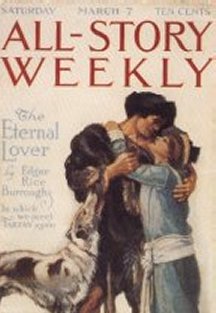 LOVECRAFT:
A BURROUGHS FAN
LOVECRAFT:
A BURROUGHS FAN
The
March 7, 1914 issue of All-Story Weekly is a rare and outstanding
on, much sought-after by collectors. There are several reasons for this.
It
is the first weekly number of the magazine. Then, again, it contains the
first printing of Edgar Rice Burroughs' fantasy novel, The Eternal Lover,
honored by a splendid cover illustration in cover.
However,
there is still another reason why the issue has a peculiar value. Tucked
away in the "Letters to the Editor" section is a most unusual missive praising
the imaginative school of fiction. Because of this and because of the probable
identity of the writer, it is reprinted below.
Providence,
Rhode Island
Editor,
The All-Story Magazine
Sir:
Having
read every number of your magazine since its beginning in January 1905,
I feel in some measure privileged to write a few words of approbation and
criticism concerning its contents.
In
the present age of vulgar taste and sordid realism it is a relief to peruse
a publication such as The All-Story, which has ever been and still
remains under the influence of the imaginative school of Poe and Verne.
For
such materialistic readers as your North-British corespondent, Mr. G.W.P.
of Dundee, there are only too many periodicals containing "probable" stories;
let The All-Story continue to hold its unique position as purveyor of literature
to those whose minds cannot be confined within the narrow circle of probability,
or dulled into a passive acceptance of the tedious round of things as they
are.
If,
in fact, man is unable to create living beings out of inorganic matter,
to hypnotize the beasts of the forests to do his will, to swing from tree
to tree with apes of the African jungle, to restore to life the mummified
corpses of the Pharaohs and the Incas, or to explore the atmosphere of
Venus and the deserts of Mars, permit us, at least in fancy, to witness
these miracles and to satisfy that craving for the unknown, the weird,
and the impossible which exists in every active human brain.
Particularly
professors and sober Scotch men may denounce it as childish the desire
for imaginative fiction; nay, I am not sure but that such a desire is childish,
and rightly so, for are not many of man's noblest attributes but the remnants
of his young nature? He who can retain in his older years the untainted
mind, the lively imagination, and the artless curiosity of his infancy,
is rather blessed than cursed; such men as those are our authors, scientists
and inventors.
At
or near the head of your list of writers Edgar Rice Burroughs undoubtedly
stands. I have read very few recent novels by others wherein is displayed
an equal ingenuity in plot, and verisimilitude in treatment. His only fault
seems to be a tendency toward scientific inaccuracy and slight inconsistencies.
For
example, in that admirable story, Tarzan of the Apes, we meet Sabor,
the tiger, far from his native India, and we behold the hero, before he
has learned the relation between vocal sounds and written letters, writing
out his name, Tarzan, which he has known only form the lips of his hairy
associates, was well as the names of Kerchak, Tantor, Numa, and
Terkoz, all of which he would not possibly have seen written.
Also,
in The Gods of Mars, Mr. Burroughs refers to the year of the red
planet as having 687 Martian days. This is, of course, absurd, for
while Mars revolves about the sun in 687 terrestrial days, its own
day or period of rotation is almost forty minutes longer than ours, thus
giving to Mars a year which contains but 668 2/3 Martian solar days.
I not with regret that this error has been repeated in Warlord of Mars.
William
Patterson White, in writing Sands o' Life, has shown himself to
be an author of the very first order. The very spirit of the old Spanish
Main pervades the pages of this remarkable novel. It is worthy of permanent
publication as a book.
In
the domain of the weird and bizarre, Lee Robinet has furnished us a masterpiece
by writing The Second Man. The atmosphere created and sustained throughout
the story can be the work only of a gifted and polished artist. Very effective
is the author's careful neglect to tell the exact location of his second
Eden.
I strongly
hope that you have added Perley Pore Sheehan permanently to your staff,
for in him may be recognized an extremely powerful writer. I have seen
Mr. Sheehan's work elsewhere, and was especially captivated by a grim short
story of his entitled "His Ancestor's Head."
William
Tillinghast Eldridge set such a standard for himself in The Forest Reaper
that it seems almost a pity for him to be the author of The Tormentor
and Cowards All.
William
Loren Curtiss tells a homely yet exciting sort of tale which exerts upon
the reader a curious fascination. "Shanty House" seems to me the best of
the two he has contributed to The All-Story.
Donald
Francis McGrew is one of the "red-blooded" school of writers; he describes
the Philippine Islands and the army there with an ease indicative of long
residence of military service on the scene of his literary productions.
I hardly
need mention the author of A Columbus of Space further than to say that
I have read every published work by Garrett P. Serviss, own most of them,
and await his future writings with eagerness. When a noted astronomer composes
an astronomical novel, we need not fear such things as years of 687 days
upon the planet Mars.
As
for your short stories, necessarily second in importance to the novels
and serials, it may be said that some of them rise much above the middle
level, while few of them fall beneath it. The merry crew of humorous writers,
such as T. Bell, Jack Brandt, Frank Condon, and Donald A. Kahn, are, though
light and sometimes a trifle silly, nevertheless distinctly amusing. Kahn
is especially clever in drawing the characters of callow college youths.
I hesitate
to criticize adversely such an excellent magazine as this, but since my
censure falls upon so small a part of it, I think I may express myself
openly without giving offense.
I fear
that a faint shadow from t he black cloud of vileness now darkening our
literature has lately fallen upon a few pages of The All-Story.
"The
Souls of Men" by Marthy M. Stanley was distinctly disagreeable tale, but
"Pilgrims of Love" by De Lysle Ferree Cass is contemptibly disgusting,
unspeakably nauseating. Mr. G.W.S. of Chicago has written that Cass "diplomatically
handles a very difficult subject -- Oriental love."
We
do not care for subjects so near allied to vulgarity, however, "diplomatically"
they may be "handled." Of such "Oriental love" we may speak in the words
of the lazy but ingenious schoolboy, who when asked by his tutor to describe
the reign of Caligula, replied, "that the less said about it the better."
We prefer a more idealized Orient to read about; let us have "nature to
advantage" as in the beautiful romance of Prince Imbecile by C.
MacLean Savage or The Invisible Empire by Stephen Chalmers.
Speaking
of the last novel, is not the title somewhat misleading? In the United
States the name "Invisible Empire" is forever associated with that nob
le but much maligned band of Southerners who protected their homes against
the diabolical freed blacks and Northern adventurers in the years of misgovernment
just after the Civil War -- the dreaded Ku-Klux-Klan.
The
broad editorial policy of The All-Story in making the magazine note merely
a local American publication, but a bond of common interest between the
United Kingdom, the United States, and the various British colonies, cannot
too heartily be commended.
Blood
is thicker than water; we are all Englishmen, and need just such a leveler
of political barriers as this to remind us of our common origin. Let the
London reader reflect, that in Boston, Toronto, Cape Town, Calcutta, Melbourne,
Auckland, and nearly everywhere else, his racial kindred are perusing the
same stirring stories that delight them.
America
may have withdrawn from the British government, but thanks to such magazines
as The All-Story, it must ever remain an integral and important part of
the great universal empire of British thought and literature.
I cannot
praise The All-Story Magazine by comparing it with others, since
it stands alone in its class, but I think I have made it clear that I hold
this publication in the highest esteem, and derive much pleasure from its
pages. What I have said in criticism of some parts of it I have said only
with friendly intent, believing that the humble opinions of one more reader
may prove not unacceptable to you.
But
ere I grow more tedious still, let me close this already protracted epistle,
and, with the best wishes for the future of The All-Story, subscribe
myself as
Your
obedient servant,
H.P.L.

It
would seem that we have probably "discovered" a little-known piece of writing
by a great master of the supernatural who is well known to lovers of the
weird tale. It gives us a glimpse of him as a "fan." And it was such letters
as his that encouraged the Munsey chain to continue printing these so-called
"different" stories, and probably let to the eventual founding of Weird
Tales magazine nine years later.
As
Howard Phillips Lovecraft wrote the above letter, I wonder if he ever imagined
that one day his own ability as an author would outrank by far the very
men he was praising!
Darrell C. Richardson


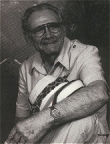
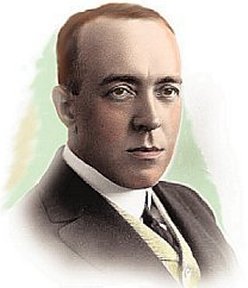
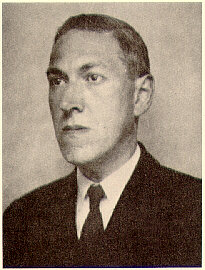
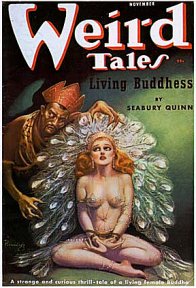

![]()
![]()
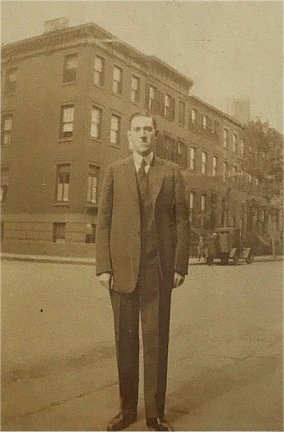
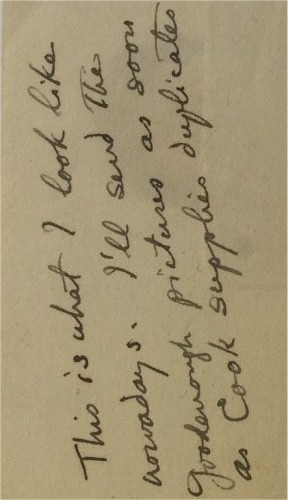
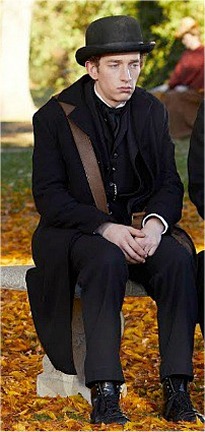
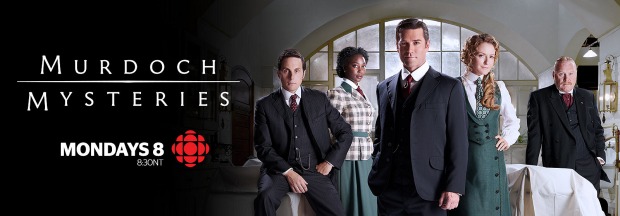
![]()
![]()
![]()
![]()
